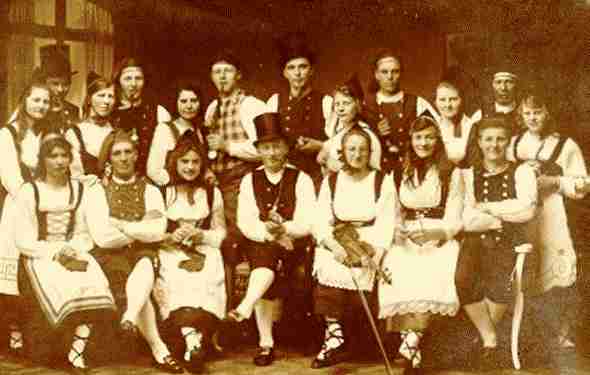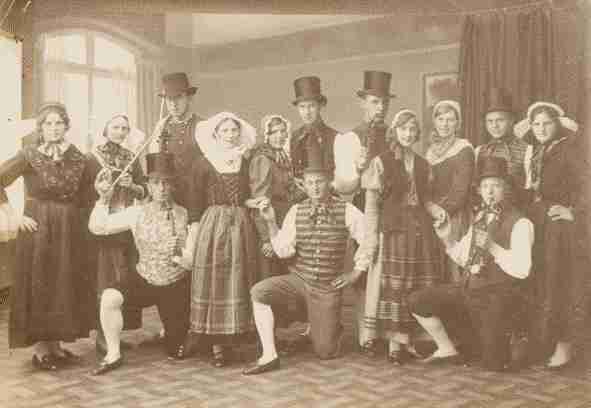
Snurrebocken (Whirring Buck) |
| Niels Mejlhede Jensen, Bøgeløvsvej 4, 2830 Virum, Denmark. e-mail (web master) |
CONTENTS: (remember: you can use Ctrl Home in usual browsers to get to the top of this page, to the links here)

Photo 1 of this week: Folk dancers from my grandfather's farm, 1922. Most of the younger dancers that met om my grandfather's farm every second week and on a neighbouring farm every other week are here photographed in their finest dance costumes. Except for three stiff hats the men wear soft knitted caps, and all the girls wear white aprons and white blouses. One of the beautiful girls here is my aunt still living strong. Last time I danced a nice folk dance with her at a big dance in West Jutland she was 92 years of age. (She is no 5 of the 14 children on the linked family photo).

Photo 2 of this week: Folk dancers from my grandfather's farm 8 years later, 1930. Half of the persons here are the same as in the photo 1 above. Now all the men (in the picture) wear stiff hats and all the girls wear colourful aprons and blouses. There is also a change in the girls' hair dresses and their shoes.
My grandfather and grandmother bought a farm with a 3 coloured cat and
9 hectares of land (= 20 acres) in 1898 for 13,500 kr (= $ 2,000) in Vendsyssel
in North Jutland. Here they got 4 daughters and 10 sons from 1899 to 1916.
My grandfather played the flute and soon invited to folk dancing. So folk
dancing of this region was for many years held at my grandparents' home
and at a neighbour's home. Eventually the 14 children came to participate
in the dance and later for some of them, also in playing the fiddle. They
danced and played the dances they liked and they knew. When the "leader"
had been one winter on folk high school on Funen he returned home with
new dances to supplement the local Vendsyssel dances. Later in the 1930's
modern dance and jazz started to become popular and was more and more wanted
as part of a dance evening. Most traditional bands could not take that
up, partly as they often did not know to read music notes, so most of the
many local folk music bands had to quit at that time. I do not consider
the dance at my grandparents' home (or elsewhere around in the countryside)
as folk dance in the sense that they conciously wanted to dance historically
correct folk dance. No, they just wanted to have a joyful time with the
good old dance and music they liked. So they could accept changes, include
some new dances and music, to a certain extent. And they would also somewhat
adjust to changes in fashion for clothes for dance events (within their
social surroundings) as we see from the two photos.
Dance of the week, 1999, March 8:
The melody can be heard in midi on computer piano in my tempo (if you
have a sound card). (The melody will loop here until you stop it. In the
table below it will play once). (I have not played the tunes here with
the "drive" I want for dance music).
| 1 | melody | the traditional good dancing melody, polished through generations of use on the fiddle | |
| . | chord
text |
Midi metronome
= 140 and 90 |
simple (folk music) chords, natural for playing the accordion;
these chords are used to make the other parts or voices in triad harmony; there should be no tension from dissonance anywhere including in octave |
| 2 | A | (Above), parallel part nearest above in third or little more above | |
| 3 | B | (Below), parallel part nearest below in third or little more below | |
| 4 | ns | simple n part; often with the tonic feeling and often with the basic dance rhythm ("motor part") | |
| 5 | C1 | C parts are made from A and B parts, and so they are two parts to the melody | |
| 6 | C2 | C2 is less simple than C1 | |
| 7 | mod =
contra part |
voice up and down (mostly) contra to the melody; it is also made from A and B | |
| 8 | n1 | n is a less constricted part, and tones from the melody are freely included | |
| 9 | nss | simple ns | |
| 10 | A | A in octave (lower) | |
| 11 | blank | . | blank staff for making your own part according to the principles here |
The music parts of this dance, "Snurrebocken" (Whirring Buck) is used
to explain the theory used to construct the parts, see
design page.
Use also octave, up and down.
Where wanted, notes can be changed according to the principles (use
a colour pencil), e.g. to improve the B part with some notes from
A.
The music is aimed at dancing, so part of the orchestra can be the
underlying "motor" when another instrument group is playing its "solo"
part (improvisation) as one of the many repetitions.
The double bass may play its usual notes, because of its low pitch.
It is better to choose a more simple part and play it well.
Accordion: beats per bar:
bar 1-8: 1+1, on beat 1 and beat 3, (beat 2 is very light)
bar 9-16: 1+2, as 3 almost equal beats
bar 17-19: on the pause tones there may be short special solo instrument
"runs"
How to play this dance: see more on the page: design of the music for this dance, Snurrebocken (Whirring Buck).
There is written a few things in Danish on the music sheets for this dance, Snurrebocken (Whirring Buck), because I have used it to explain the making of the music parts. At the top it tells examples of music instruments for this transposed note sheet, and at the bottom the dance description is summarized.
(Help coming back from that note
sheet: CLICK the note sheet to come back to this page, or just close
the note window.
Remember: the note sheet opens in a new separate window, and that may
cover the whole screen. The back button in the tools bar does probably
not work because the window is new, with no history. All you see on the
page are notes because I have placed no link back here for not disturbing
easy submitting to the printer. Close the note window with a click at the
top or with Alt F4, or minimize or reduce the window, or ..., and you are
back to the main page that was there behind all the time).